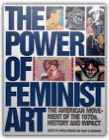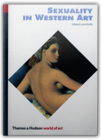|
'INVENTED LIVES: NARRATIVES OF BLACK WOMEN, 1860-1960'

Ain't I a Woman: Black Women and Feminism

Alone of all Her Sex: The myth and Cult of the Virgin Mary

Alter/Image: Feminism and representation in New Zealand art 1973 - 1993

Art on My Mind: Visual Politics

Backlash: The Undeclared War Against American Women

Beyond Power On Women Men and Morals

Centering Woman: Gender Discourses in Caribbean Slave Society

Cosmetics, Fashions, and the Exploitation of Women

The Female Body in Western Culture: Contemporary Perspectives

In The Female Body in Western Culture, twenty-three internationally noted scholars and critics, in specially commissioned essays, explore these representations and their consequences for contemporary art and culture. Ranging from Genesis to Gertrude Stein and Angela Carter, from ancient Greek ritual to the Victorian sleeping cure, from images of the Madonna to modern film and Surrealist art, the essays cover a wide spectrum of approaches and subject mailer. They all converge, however, around questions of power and powerlessness, voice and silence, subjecthood and objectification. And they point the way to the new possibilities and displacements of traditional male-female oppositions. Androgyny in a new key? This book demonstrates that a blurring of gender boundaries does not have to deny difference. Feminism and Art History: Questioning the Litany

Feminist Studies

Feminist Studies

Gyn/Ecology - The Metaethics of Radical Feminism

Imperial Leather: Race, Gender, and Sexuality in the Colonial Contest

In Search of Our Mothers' Gardens: Womanist Prose

The Last Painting of Sara de Vos: A Novel

Amsterdam, 1631: Sara de Vos becomes the first woman to be admitted as a master painter to the city's Guild of St. Luke. Though women do not paint landscapes (they are generally restricted to indoor subjects), a wintry outdoor scene haunts Sara: She cannot shake the image of a young girl from a nearby village, standing alone beside a silver birch at dusk, staring out at a group of skaters on the frozen river below. Defying the expectations of her time, she decides to paint it. New York City, 1957: The only known surviving work of Sara de Vos, At the Edge of a Wood, hangs in the bedroom of a wealthy Manhattan lawyer, Marty de Groot, a descendant of the original owner. It is a beautiful but comfortless landscape. The lawyer's marriage is prominent but comfortless, too. When a struggling art history grad student, Ellie Shipley, agrees to forge the painting for a dubious art dealer, she finds herself entangled with its owner in ways no one could predict. Sydney, 2000: Now a celebrated art historian and curator, Ellie Shipley is mounting an exhibition in her field of specialization: female painters of the Dutch Golden Age. When it becomes apparent that both the original At the Edge of a Wood and her forgery are en route to her museum, the life she has carefully constructed threatens to unravel entirely and irrevocably. The Living Goddesses

This volume, which was close to completion at the time of her death, contains the distillation of her studies, combined with new discoveries, insights, and analysis. Editor Miriam Robbins Dexter has added introductory and concluding remarks, summaries, and annotations. The first part of the book is an accessible, beautifully illustrated summation of all Gimbutas's earlier work on "Old European" religion, together with her ideas on the roles of males and females in ancient matrilineal cultures. The second part of the book brings her knowledge to bear on what we know of the goddesses today—those who, in many places and in many forms, live on. The Madwoman Can't Speak: Or Why Insanity is Not Subversive

Caminero-Santangelo considers such writers as Toni Morrison, Eudora Welty, Sylvia Plath, Cristina Garcia, Kate Millett, Helena Maria Viramontes, and Shirley Jackson, locating their narratives of female madness within the context of popularized Freudianism, sociology of "the" African-American family, images in the mass media, and other elements of culture to which their writings respond. Their works, Caminero-Santangelo maintains, appropriate images linking madness to feminine aberrance, but do so to expose the regulatory functions that such images serve. These writings reveal how the silent protest emblematized by the madwoman, and celebrated in feminist critical practice, simply serves to lock women into stereotypes long used to oppress them. The Madwoman Can't Speak offers an alternative explanation for the compelling nature of the figure of the madwoman, allowing a critical move away from the dangerous, ultimately disempowering notions of the subversive potential of madness. Marriage as a Trade

New Feminist Art Criticism

The Origin of the World: Science and Fiction of the Vagina

Drenth describes the workings of the vagina in simple language, enriching his description throughout the book with the imagery, mythology, lore, and history that has surrounded the vagina since the Middle Ages. The Origin of the World moves from basic physiognomic facts to the realms of anthropology, art history, science fiction, and feminist literature-all in the service of mapping the dark continent. Drenth's journey takes him from Renaissance woodcuts to vibrators, clitoridectomies to "virginity checks," fears of the vagina (the vagina dentata) to its celebration. Part medical exposition covering the function of female genitalia from orgasm to pregnancy and part cultural history discussing contemporary and historical views of such aspects of the feminine as pubic hair, Freud's theories of coitus, and slang terms for the vagina, The Origin of the World is encyclopedic in its breadth, fascinating in its content, and familiar in its subject. This lightly written exploration can be seen as both an owner's manual and a guide for the perplexed. Women and men alike will benefit from its entertaining erudition and from its fundamental mission of demystifying sex and sexuality in the service of greater understanding and, from that understanding, greater pleasure. (20041101) Power of Feminist Art

SEVEN WOMEN: Portraits from the American Radical Tradition

Sex, Art, and American Culture: Essays

Sexuality in Western Art

Sister Outsider: Essays and Speeches

Slaying the Mermaid: Women and the Culture of Sacrifice

Drawing on the experiences of a diverse array of women, Stephanie Golden examines the dichotomy between selfhood and sacrifice, enabling women to become conscious of self-defeating behavior. Using the image of Hans Christian Andersen's Little Mermaid, the ultimate ideal of the self-sacrificing woman, Golden offers a new paradigm: in order to run with the wolves, you must first slay the mermaid. Slaying the Mermaid uncovers the mythic and archetypal roots of the need felt by women to sacrifice their personal potential for the good of others. This book will help women reclaim their energy, creativity, and identity, while rediscovering the original, empowering meaning of sacrifice as an expansive and self-fulfilling act. Speculum of the Other Woman

In the last section, "Plato's Hystera," Irigaray reinterprets Plato's myth of the cave, of the womb, in an attempt to discover the origins of that ideology, to ascertain precisely the way in which metaphors were fathered that henceforth became vehicles of meaning, to trace how woman came to be excluded from the production of discourse. Between these two sections is "Speculum"-ten meditative, widely ranging, and freely associational essays, each concerned with an aspect of the history of Western philosophy in its relation to woman, in which Irigaray explores woman's essential difference from man. V360 Seizing Our Bodies

Vagina: Revised and Updated

A “New Biography,” Vagina is at once serious, provocative, and immensely entertaining—a radical and endlessly fascinating exploration of the gateway to female consciousness from a remarkable writer and thinker at the forefront of the new feminism. Visibly Female: Feminism and Art : An Anthology

The Woman's Dictionary of Symbols and Sacred Objects

Unique organization by shape of symbol or type of sacred object 21 different sections including Round and Oval Motifs, Sacred Objects, Secular-Sacred Objects, Rituals, Deities' Signs, Supernaturals, Body Parts, Nature, Birds, Plants, Minerals, Stones and Shells, and more Introductory essays for each section 753 entries and 636 illustrations Alphabetical index for easy reference Three-Rayed Sun The sun suspended in heaven by three powers, perhaps the Triple Goddess who gave birth to it (see Three-Way Motifs). Corn Dolly An embodiment of the harvest to be set in the center of the harvest dance, or fed to the cattle to `make them thrive year round' (see Secular-Sacred Objects). Tongue In Asia, the extended tongue was a sign of life-force as the tongue between the lips imitated the sacred lingam-yoni: male within female genital. Sticking out the tongue is still a polite sign of greeting in northern India and Tibet (see Body Parts). Cosmic Egg In ancient times the primeval universe-or the Great Mother-took the form of an egg. It carried all numbers and letters within an ellipse, to show that everything is contained within one form at the beginning (see Round and Oval Motifs). The Woman's Encyclopedia of Myths and Secrets

where the legend of a cat's nine lives comes from? why "mama" is a word understood in nearly all languages? how the custom of kissing began? whether there really was a female pope? why Cinderella's glass slipper was so important to the Prince? The answers to these and countless other intriguing questions are given in this compulsively readable, feminist encyclopedia. Twenty-five years in preparation, this unique, comprehensive sourcebook focuses on mythology anthropology, religion, and sexuality to uncover precisely what other encyclopedias leave out or misrepresent. The Woman's Encyclopedia presents the fascinating stories behind word origins, legends, superstitions, and customs. A browser's delight and an indispensable resource, it offers 1,350 entries on magic, witchcraft, fairies, elves, giants, goddesses, gods, and psychological anomalies such as demonic possession; the mystical meanings of sun, moon, earth, sea, time, and space; ideas of the soul, reincarnation, creation and doomsday; ancient and modern attitudes toward sex, prostitution, romance, rape, warfare, death and sin, and more. Tracing these concepts to their prepatriarchal origins, Barbara G. Walker explores a "thousand hidden pockets of history and custom in addition to the valuable material recovered by archaeologists, orientalists, and other scholars." Not only a compendium of fascinating lore and scholarship, The Woman's Encyclopedia is a revolutionary book that offers a rare opportunity for both women and men to see our cultural heritage in a fresh light, and draw upon the past for a more humane future. Women of Barbados: Amerindian era to mid 20th Century

A Women's History of Sex

Women, Art, and Power and Other Essays

Women, Art, and Society

|


Annalee Davis
Collection Total:
3597 Items
3597 Items
Last Updated:
Sep 7, 2017
Sep 7, 2017
 Made with Delicious Library
Made with Delicious Library